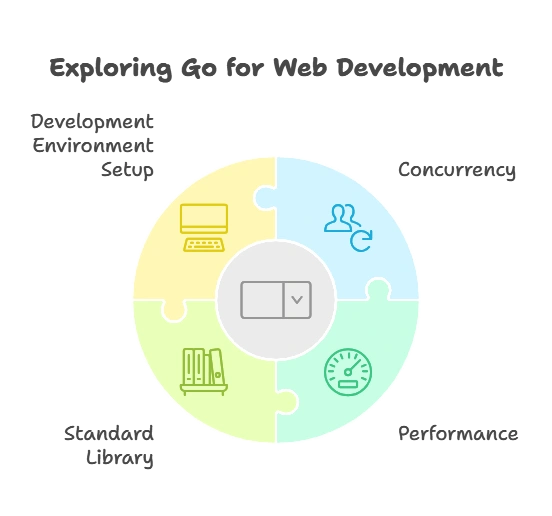Web Development with Go
In this comprehensive chapter, we'll explore the world of web development with Go. From basic concepts to advanced techniques, we'll cover everything you need to know to build powerful web applications using the Go programming language. By the end of this chapter, you'll have a solid understanding of web development principles and be equipped to create dynamic and scalable web applications in Go.
Introduction to Web Development with Go
Understanding Web Development
Web development involves creating applications that run on the internet, accessible through web browsers. These applications can range from simple websites to complex web-based systems. In this chapter, we’ll focus on building web applications using Go.
Advantages of Using Go for Web Development
- Concurrency: Go’s built-in concurrency features make it well-suited for handling multiple simultaneous requests efficiently.
- Performance: Go’s compiled nature and efficient runtime result in fast execution speeds, making it ideal for high-performance web applications.
- Standard Library: Go’s standard library provides excellent support for building web servers and handling HTTP requests, reducing the need for external dependencies.
Setting Up Your Development Environment
Before we dive into coding, let’s set up our development environment. Ensure you have Go installed on your system and a text editor or IDE of your choice.

Building a Simple Web Server
Creating a Basic HTTP Server
package main
import (
"fmt"
"net/http"
)
func handler(w http.ResponseWriter, r *http.Request) {
fmt.Fprintf(w, "Hello, World!")
}
func main() {
http.HandleFunc("/", handler)
http.ListenAndServe(":8080", nil)
}
http.HandleFunc()registers a handler function for the root URL (“/”).http.ListenAndServe()starts an HTTP server on port 8080, using the default router.
Handling Different Routes
func aboutHandler(w http.ResponseWriter, r *http.Request) {
fmt.Fprintf(w, "About Page")
}
func contactHandler(w http.ResponseWriter, r *http.Request) {
fmt.Fprintf(w, "Contact Page")
}
func main() {
http.HandleFunc("/", handler)
http.HandleFunc("/about", aboutHandler)
http.HandleFunc("/contact", contactHandler)
http.ListenAndServe(":8080", nil)
}
- Additional handler functions are registered for specific routes (“/about”, “/contact”).
- Each handler function responds with different content based on the route.
Working with Templates and Static Files
Rendering HTML Templates
import "html/template"
func handler(w http.ResponseWriter, r *http.Request) {
tpl := template.Must(template.ParseFiles("index.html"))
tpl.Execute(w, nil)
}
- Go’s
html/templatepackage is used to parse and execute HTML templates. - Templates can contain placeholders that are replaced with dynamic data during execution.
Serving Static Files (CSS, JavaScript, Images)
func main() {
http.Handle("/static/", http.StripPrefix("/static/", http.FileServer(http.Dir("static"))))
http.HandleFunc("/", handler)
http.ListenAndServe(":8080", nil)
}
http.FileServer()creates an HTTP handler to serve files from the specified directory.http.StripPrefix()removes a prefix from the request URL to map it to the file system correctly.
Working with Databases
Integrating a Database with Your Web Application
import (
"database/sql"
_ "github.com/go-sql-driver/mysql"
)
func main() {
db, err := sql.Open("mysql", "user:password@tcp(localhost:3306)/dbname")
if err != nil {
panic(err)
}
defer db.Close()
// Use db for database operations within your handlers
}
database/sqlpackage is used to interact with databases in Go.- Replace
"github.com/go-sql-driver/mysql"with the appropriate driver for your database.
Performing CRUD Operations
func getUsers(w http.ResponseWriter, r *http.Request) {
rows, err := db.Query("SELECT * FROM users")
// Handle errors and process query results
}
func createUser(w http.ResponseWriter, r *http.Request) {
_, err := db.Exec("INSERT INTO users (name, email) VALUES (?, ?)", name, email)
// Handle errors and respond accordingly
}
- Use SQL queries to perform Create, Read, Update, and Delete operations on your database.
- Ensure proper error handling to deal with potential issues like database connection errors or query failures.
Authentication and Authorization
Implementing User Authentication
database/sqlpackage is used to interact with databases in Go.- Replace
"github.com/go-sql-driver/mysql"with the appropriate driver for your database.
func loginHandler(w http.ResponseWriter, r *http.Request) {
// Verify credentials and generate session tokens
}
func logoutHandler(w http.ResponseWriter, r *http.Request) {
// Invalidate session tokens and log out user
}
- Implement login and logout handlers to authenticate users and manage their sessions.
- Use techniques like password hashing and session management to secure user authentication.
In this chapter, we've covered the fundamentals of web development with Go, including setting up a basic web server, handling routes, working with templates and static files, integrating databases, and implementing authentication and authorization. Armed with this knowledge, you're well-equipped to embark on your journey to build robust and scalable web applications using the Go programming language. Keep exploring and experimenting with different techniques to hone your skills and create amazing web experiences. Happy coding !❤️
Table of Contents

